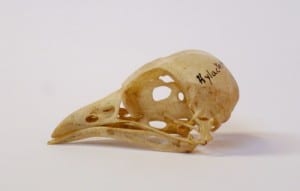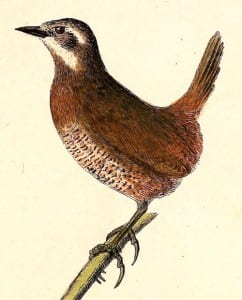Specimen of the Week: Week 186
By Tannis Davidson, on 4 May 2015
 Sometimes a specimen can tell you a little. Sometimes it can tell you a lot. There has been much written on this blog about the perils and pitfalls of museum documentation. Sometimes there is no information with a specimen – no accession record, no acquisition information, no species name and (occasionally) no specimen. Objects get lost and misplaced. Historical records are incomplete or indecipherable. Specimen labels become separated from their object.
Sometimes a specimen can tell you a little. Sometimes it can tell you a lot. There has been much written on this blog about the perils and pitfalls of museum documentation. Sometimes there is no information with a specimen – no accession record, no acquisition information, no species name and (occasionally) no specimen. Objects get lost and misplaced. Historical records are incomplete or indecipherable. Specimen labels become separated from their object.
Alternatively, some specimens may have (dare I say it) too much information which may include multiple numbers, several differing records, erroneous taxonomic information or questionable identifications.
Caring for a collection entails many things but first and foremost is to identify the collection itself – through all possible means including the consolidation of any (and all) associated information. When luck prevails, one may find a scrap (literally) of information which ties it all together – a word or two which allows a specimen to be given a name, a record, a life!
Recently while going through the bird drawers, I came across an unaccessioned skull and mandible together with its associated information (unclear object number, outdated taxonomic name) including a small piece of paper with two words: “El Turco”. This week’s Specimen of the Week is…
***Pteroptochos megapodius ***
1. A bird by any other name…
From this morsel of information I discovered this charismatic little animal and the interesting tales surrounding its discovery and naming. Also known as the moustached turca, Pteroptochos megapodius is the scientific name for the bird called ‘el turco’ in its native Chile. It was previous known as Hylactes megapodius, which is written on the back of the skull. Hylactes was first described in 1830 by the German naval officer, artist, explorer and naturalist Heinrich von Kittlitz following his voyage around the world between 1826 and 1829 on the Russian Senjawin expedition. He returned to St Petersburg with 754 specimens of 314 bird species and published several volumes in the years following describing and illustrating birds and vegetation collected on his travels.
2. Tapaculo
‘El Turco’ has a few other names to add to the list. In Portugeuse and Spanish it is known as ‘turca’, ‘huet-huet’ or ‘huet-huet turca’. It is also referred to as a ‘tapaculo’ or ‘tapacolo’ from the name given to the group of 12 genera within the family Rhinocryptidae. They are passerine birds – distinguished by the arrangement of their toes (three pointing forward and one back) which facilitates perching. Tapaculos are medium sized terrestrial birds that fly poorly on their short wings. The musical call of one species of these songbirds, Scerlorchilus albicollis (also described by von Kittlitz), is possibly the onomatopaeic origin of the nickname ‘tapaculo’.
3. Darwinian description
There is however, another origin story of the name ‘tapaculo’ for these birds. The literal translation from Spanish means ‘cover your bottom’ and is apt considering the erect manner in which tapaculos hold their tails bent over backwards.
In his journal of the Voyage of the Beagle, Charles Darwin gave special mention to Pteroptochus megapodius and P. albicollis referring to the local use of the nicknames of each: the former as ‘el turco’ and the latter as ‘tapacolo’. His charming descriptions make much of their tail postures:
(Describing el turco) “It really requires little imagination to believe that the bird is ashamed of itself, and is aware of its most ridiculous figure. On first seeing it, one is tempted to exclaim, ‘A vilely stuffed specimen has escaped from some museum, and has come to life again!’ “(1)
“The second species (or P. albicollis) is allied to the first in its general form. It is called Tapacolo, or “cover your posterior;” and well does the shameless little bird deserve its name; for it carries its tail more than erect, that is, inclined backwards towards its head… it bears a close resemblance to the Turco; but its appearance is not quite so ridiculous.” (2)
4. Beast feet
The sharp-eyed Ancient Greek-readers out there have likely noticed the species name of this week’s SOTW and would be correct to imagine that it has some large legs and feet. Indeed, Pteroptochus megapodius is differentiated from P. albicollis by its thick, stilt-like legs and massive feet on which it hops about.
5. What’s in a name
So, we’ve managed to paint quite a picture of what this bird looks like – from just the skull and mandible, and of course, its supporting information. Having never seen one myself, I can imagine not only how it looks, but also how it moves and sounds. I’m tempted to end this blog here – in the spirit of our current exhibition Strange Creatures whereby the theme of depicting and describing unknown animals is explored – and allow for just the imagination to provide an image of this bird. However, not to be unkind, here is El Turco in all its glory as depicted by von Kittlitz himself:
Tannis Davidson is Curatorial Assistant at the Grant Museum of Zoology
References
Darwin, Charles (1845), Journal of researches into the natural history and geology of the countries visited during the voyage of H.M.S. Beagle round the world, under the Command of Capt. Fitz Roy, R.N. (Second ed.), London: John Murray (The Voyage of the Beagle) Retrieved on 27 April 2015
 Close
Close




